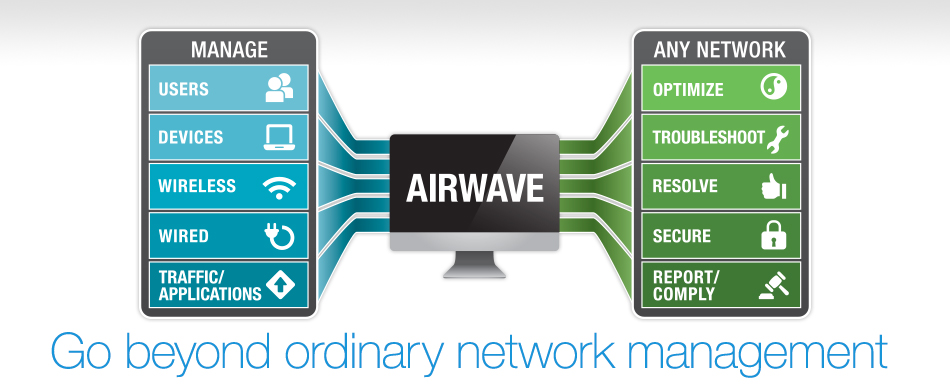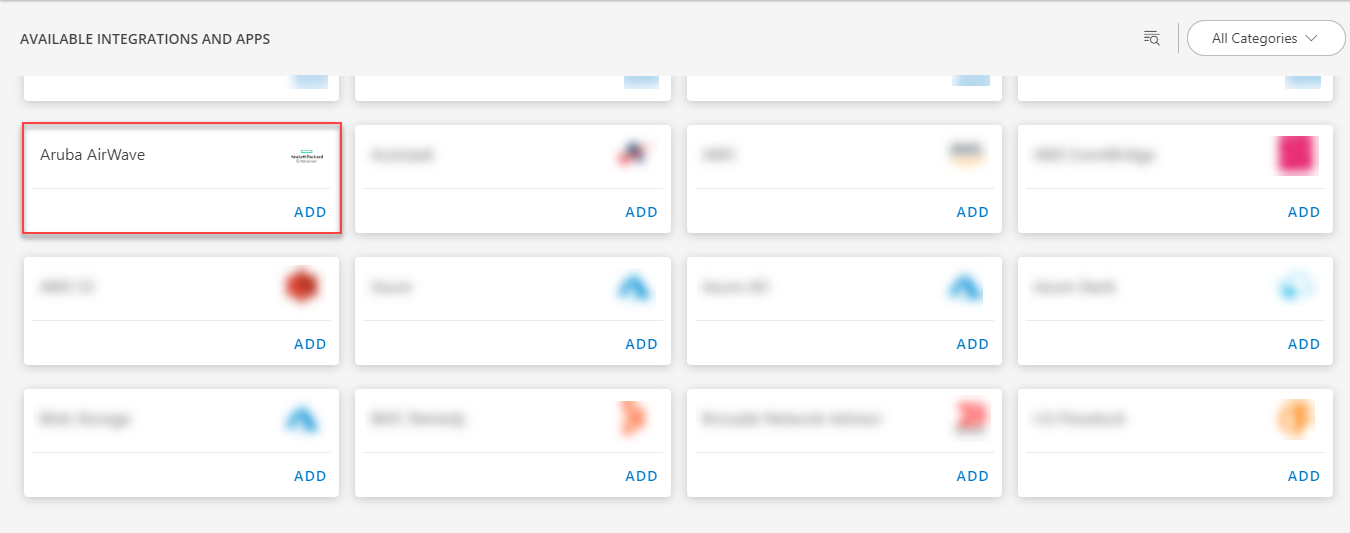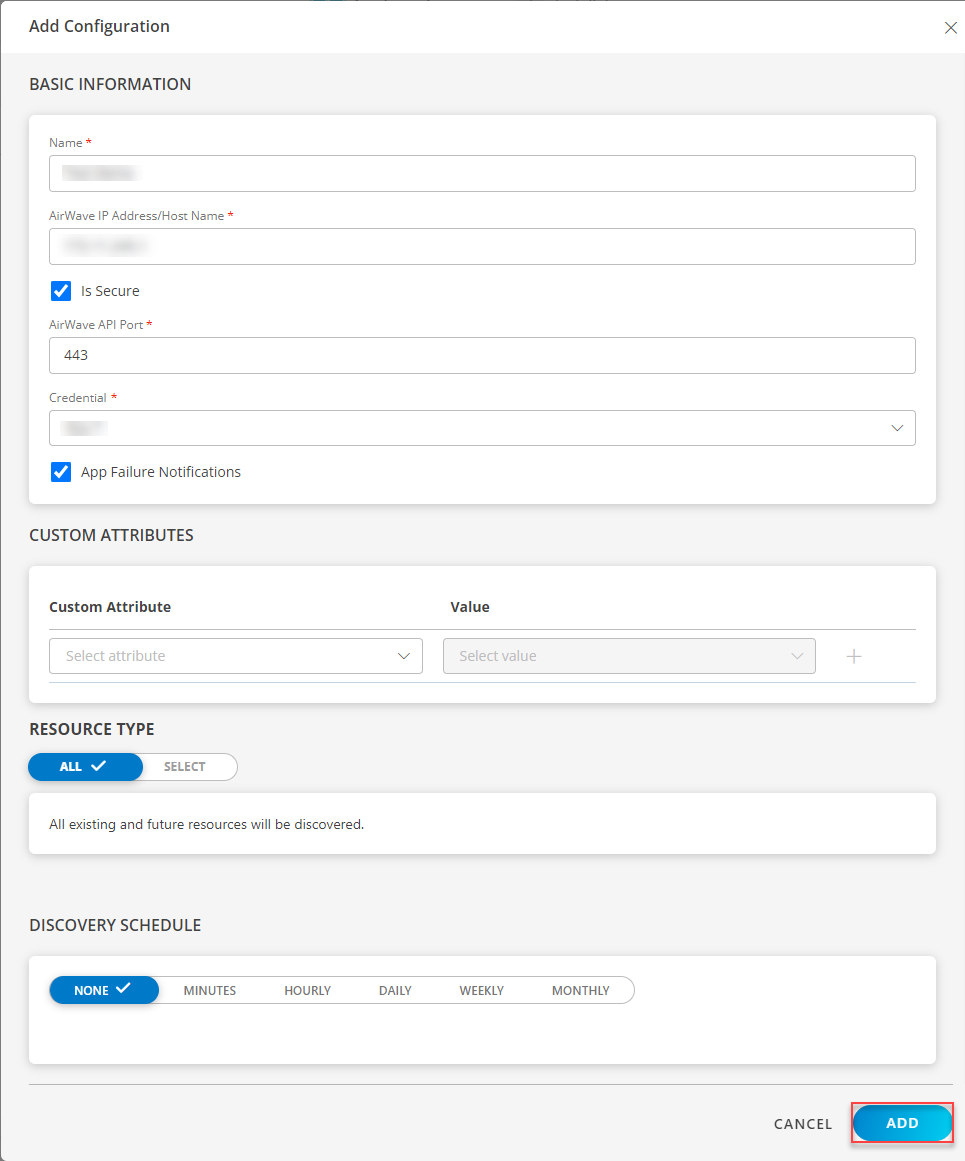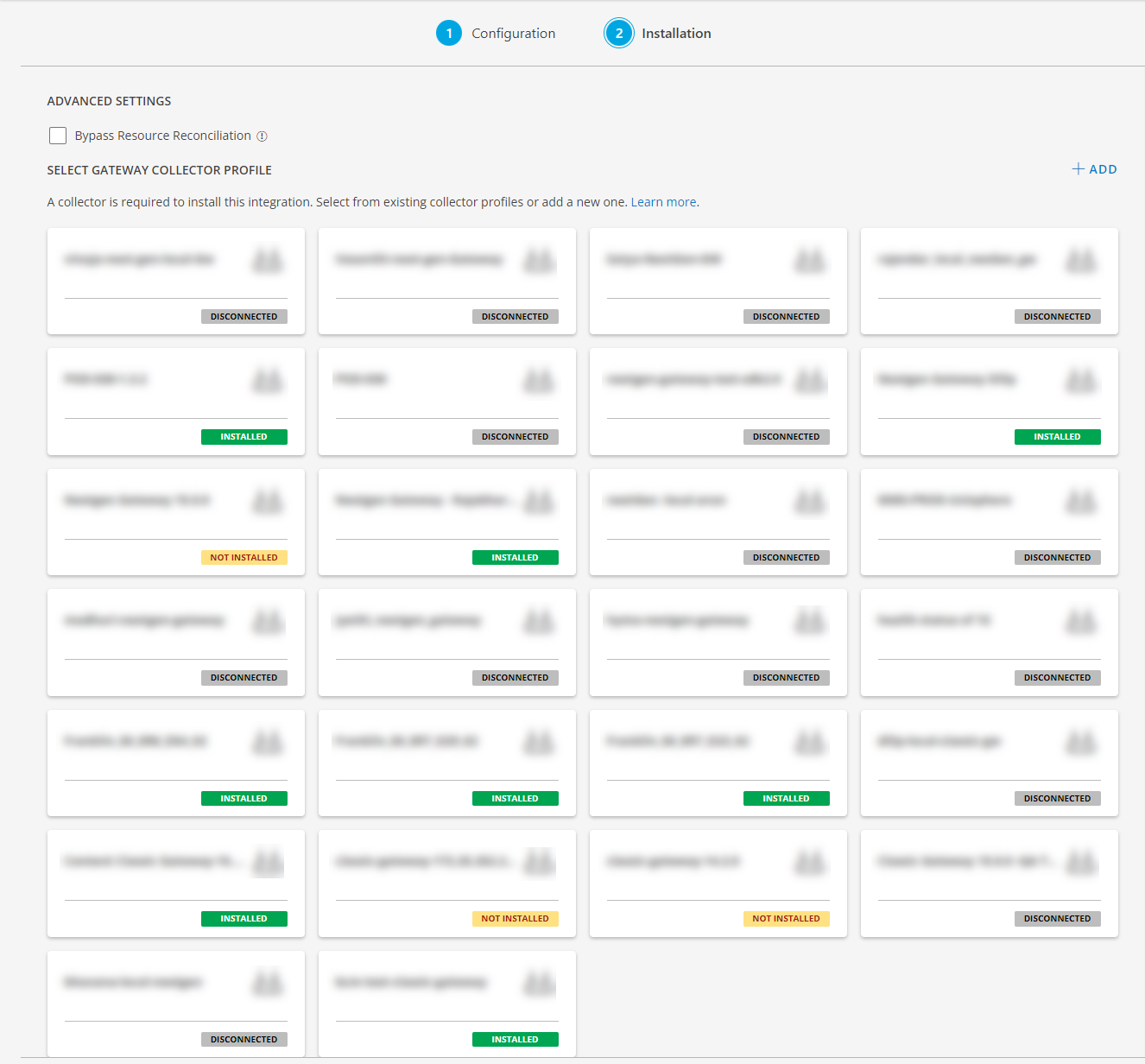| Supported Target Versions |
|---|
| 8.2.15.1 |
Application Version and Upgrade Details
| Application Version | Bug fixes / Enhancements |
|---|---|
| 1.0.0 | Initial SDK2.0 app Discovery and Monitoring Implementations. |
Introduction
AirWave is an API tool that collects and analyzes vast amounts of data from multiple network components, including access points, controllers, switches, and authentication sources. AirWave can provide this valuable information to other wireless applications, relegating the need for these applications to develop direct interfaces with these components.
Examples of wireless applications that would require AMP’s correlated information are RF scanning IDS solutions, RF scanning analysis solutions, and wireless site planning tools. The API uses Extensible Markup Language(XML) over HTTPS using session- based authentication. All HTTP parameters and form fields must be URL encoded.

With visibility into everything that affects wireless and mobility service-level agreements (SLAs), AirWave lets you proactively plan for capacity, visualize client performance and troubleshoot application issues before you get a help desk ticket.
With AirWave, your entire distributed enterprise – from campuses to branch offices around town and around the world – are easily and efficiently managed from a single pane of glass, making it easy to keep your SLAs on track.
Prerequisites
- OpsRamp Classic Gateway 14.0.0 and above.
- OpsRamp NextGen Gateway 14.0.0 and above.
Note: OpsRamp recommends using the latest Gateway version for full coverage of recent bug fixes, enhancements, etc. - Provided IpAddress/hostname, Credentials should work for AirWave API Integrations REST API’s.
Hierarchy of AirWave API resources
• AirWave Management Platform (AMP)
- AirWave Access Points
- AirWave Air Monitors
- AirWave Remote Access Points
- AirWave Virtual Controllers
- AirWave Physical Controllers
Default Monitoring Configurations
Aruba AirWave has default Global Device Management Policies, Global Templates, Global Monitors and Global metrics in OpsRamp. You can customize these default monitoring configurations as per your business use cases by cloning respective global templates and global Device Management Policies. OpsRamp recommends performing the below activity before installing the application to avoid noise alerts and data.
Default Global Device Management Policies
OpsRamp has a Global Device Management Policy for each Native Type of AirWave Management Platform. You can find those Device Management Policies at Setup > Resources > Device Management Policies, search with suggested names in global scope. Each Device Management Policy follows below naming convention:
{appName nativeType - version}Ex: aruba-airwave AirWave Management Platform - 1 (i.e, appName = aruba-airwave, nativeType =AirWave Management Platform, version = 1)
Default Global Templates
OpsRamp has a Global template for each Native Type of AirWave Management Platform. You can find those templates at Setup > Monitoring > Templates, search with suggested names in global scope. Each template follows below naming convention:
{appName nativeType 'Template' - version}Ex: aruba-airwave AirWave Management Platform Template - 1 (i.e, appName = aruba-airwave, nativeType = AirWave Management Platform, version = 1)
Default Global Monitors
OpsRamp has a Global Monitors for each Native Type which has monitoring support. You can find those monitors at Setup > Monitoring > Monitors, search with suggested names in global scope. Each Monitors follows below naming convention:
{monitorKey appName nativeType - version}Ex: AirWave Management Platform Monitor aruba-airwave AirWave Management Platform 1 (i.e, monitorKey = AirWave Management Platform Monitor, appName = aruba-airwave, nativeType = AirWave Management Platform, version= 1)
Configure and Install the Aruba AirWave Integration
- From All Clients, select a client.
- Go to Setup > Account.
- Select the Integrations and Apps tab.
- The Installed Integrations page, where all the installed applications are displayed.
Note: If there are no installed applications, it will navigate to the Available Integrations and Apps page. - Click + ADD on the Installed Integrations page. The Available Integrations and Apps page displays all the available applications along with the newly created application with the version.
Note: You can even search for the application using the search option available. Also you can use the All Categories option to search.

- Click ADD in the Aruba AirWave application.
- In the Configuration page, click + ADD. The Add Configuration page appears.
- Enter the below mentioned BASIC INFORMATION:
| Functionality | Description |
|---|---|
| Name | Enter the name for the configuration. |
| AirWave IP Address/Host Name | Enter the Host name or the IP address. |
| AirWave API Port | API Port information Note: By default 443 is added. |
| Credentials | Select the credentials from the drop-down list. Note: Click + Add to create a credential. |
Notes:
- By default the Is Secure checkbox is selected.
- AirWave Ip Address/Host Name and AirWave API Port should be accessible from Gateway.
- Select the following:
- App Failure Notifications: if enabled,
- an alert will be sent to the registered gateway resource.
- an alert is raised for connectivity, authentication exception,
- Discovery - alert will be on a gateway resource that is registered with the application.
- Monitoring - alert will be on a particular Powerflex resource.
- App Failure Notifications: if enabled,
- Select the below mentioned CUSTOM ATTRIBUTES:
| Functionality | Description |
|---|---|
| Custom Attribute | Select the custom attribute from the drop down list box. |
| Value | Select the value from the drop down list box. |
Note: The custom attribute that you add here will be assigned to all the resources that are created by the integration. You can add a maximum of five custom attributes (key and value pair).
- In the RESOURCE TYPE section, select:
- ALL: All the existing and future resources will be discovered.
- SELECT: You can select one or multiple resources to be discovered.
- In the DISCOVERY SCHEDULE section, select Recurrence Pattern to add one of the following patterns:
- Minutes
- Hourly
- Daily
- Weekly
- Monthly
- Click ADD.

Now the configuration is saved and displayed on the configurations page after you save it.
Note: From the same page, you may Edit and Remove the created configuration.
13. Click NEXT.
14. Below are the optional steps you can perform on the Installation page.
Under the ADVANCED SETTINGS, Select the Bypass Resource Reconciliation option, if you wish to bypass resource reconciliation when encountering the same resources discovered by multiple applications.
Note: If two different applications provide identical discovery attributes, two separate resources will be generated with those respective attributes from the individual discoveries.

- Click +ADD to create a new collector by providing a name or use the pre-populated name.

- Select an existing registered profile.

- Click FINISH.
The integration is installed and displayed on the INSTALLED INTEGRATION page. Use the search field to find the installed integration.
See Modify an Installed Integration or Application article.
Note: Select the Aruba AirWave application.
View the Aruba AirWave Details
The discovered resource(s) are displayed in Infrastructure > Resources > Network Device, with Native Resource Type as AirWave Access Points. You can navigate to the Attributes tab to view the discovery details, and the Metrics tab to view the metric details for Aruba AirWave.

View resource metrics
- Metric graphs: A graph is plotted for each metric that is enabled in the configuration.
- Alerts: Alerts are generated for metrics that are configured as defined for integration.

Resource Type Filter Keys
Aruba Airwave application Resources are filtered and discovered based on below keys:
Click here to view the Supported Input Keys
| Resource Type | Resource Type |
|---|---|
| All Types | resourceName |
| hostName | |
| aliasName | |
| dnsName | |
| ipAddress | |
| macAddress | |
| os | |
| make | |
| model | |
| serialNumber | |
| AirWave Management Platform | Console Refresh Rate |
| FailOver Status | |
| version | |
| AirWave Access Points | Controller Name |
| FirmWare | |
| Folder Name | |
| Group Name | |
| Last Contacted | |
| Last Reboot | |
| Root Resource HostName | |
| SSID | |
| AirWave Air Monitors | Controller Name |
| FirmWare | |
| Folder Name | |
| Group Name | |
| Last Contacted | |
| Last Reboot | |
| Root Resource HostName | |
| SSID | |
| AirWave Remote Access Points | Controller Name |
| FirmWare | |
| Folder Name | |
| Group Name | |
| Last Contacted | |
| Last Reboot | |
| Root Resource HostName | |
| SSID | |
| AirWave Virtual Controllers | FirmWare |
| Folder Name | |
| Group Name | |
| Last Contacted | |
| Last Reboot | |
| Root Resource HostName | |
| SSID | |
| AirWave Physical Controllers | FirmWare |
| Folder Name | |
| Group Name | |
| Last Contacted | |
| Last Reboot | |
| Root Resource HostName | |
| SSID |
Supported Metrics
Click here to view the supported metrics
| Native Type | Metrics | Display Name | Units | Application Version | Description |
|---|---|---|---|---|---|
| AirWave Physical Controllers | airwave_devices_clientCount | AirWave Devices Clients Count | count | 1.0.0 | Provides the number of AirWave Devices Clients Count. |
| airwave_devices_configurationUnknownCount | AirWave Devices Configuration Unknown | count | 1.0.0 | Provides the number of AirWave Devices Configuration Unknown Count. | |
| airwave_devices_downCount | AirWave Devices Down Count | count | 1.0.0 | Provides the number of AirWave Devices Down Count. | |
| airwave_devices_downWiredCount | AirWave Devices Down Wired Count | count | 1.0.0 | Provides the number of AirWave Devices Down Wired Count. | |
| airwave_devices_downWirelessCount | AirWave Devices Wireless Count | count | 1.0.0 | Provides the number of AirWave Devices Wireless Count. | |
| airwave_devices_mismatchedCount | AirWave Devices Mismatched Count | count | 1.0.0 | Provides the number of AirWave Devices Mismatched Count. | |
| airwave_devices_newCount | AirWave Devices New Count | count | 1.0.0 | Provides the number of AirWave Devices New Count. | |
| airwave_devices_rogueCount | AirWave Devies Rogue Count | count | 1.0.0 | Provides the number of AirWave Devices Rogue Count. | |
| airwave_devices_upCount | AirWave Devies Up Count | count | 1.0.0 | Provides the number of AirWave Devices Up Count. | |
| airwave_devices_upWiredCount | AirWave Devies Up Wired Count | count | 1.0.0 | Provides the number of AirWave Devices Up Wired Count. | |
| airwave_devices_upWirelessCount | AirWave Devies Up Wireless Count | count | 1.0.0 | Provides the number of AirWave Devices Up Wireless Count. | |
| airwave_devices_vpnAllUsersCount | AirWave Devies VPN All Users Count | count | 1.0.0 | Provides the number of AirWave Devices VPN All Users Count. | |
| airwave_devices_vpnCount | AirWave Devies VPN Count | count | 1.0.0 | Provides the number of AirWave Devices VPN Count. | |
| airwave_devices_alertsCount | AirWave Devices Alerts Count | count | 1.0.0 | Provides the number of Airwave Devices Alerts Count. | |
| airwave_devices_auditDisabledCount | AirWave Devices Audit Disabled Count | count | 1.0.0 | Provides the number of AirWave Devices Audit Disabled Count. | |
| airwave_devices_severeAlertsCount | AirWave Devices Severe Alerts Count | count | 1.0.0 | Provides the number of AirWave Devices Severe Alerts Count. | |
| airwave_resource_APIStats | AirWave Resource API Statistics | count | 1.0.0 | Provides the number of API calls and resources made within the frequency. | |
| AirWave Access Points | airwave_access_point_status | AirWave Access Point Status | 1.0.0 | Provides Status of the AirWave Access Points, possible value are 0 : true and 1 : false. | |
| airwave_access_point_clientCount | AirWave Access Point Clients Count | count | 1.0.0 | Provides the number of Clients connected to the device. | |
| AirWave Air Monitors | airwave_air_monitor_status | AirWave Air Monitor Status | 1.0.0 | Provides Status of the AirWave Air Monitor possible value are 0 : true and 1 : false. | |
| airwave_air_monitor_clientCount | AirWave Air Monitor Clients Count | count | 1.0.0 | Provides the number of Clients connected to the device. | |
| AirWave Remote Access Points | airwave_remote_access_point_status | AirWave Remote Access Point Status | 1.0.0 | Provides Status of the AirWave Remote Access Points, possible value are 0 : true and 1 : false. | |
| airwave_remote_access_point_clientCount | AirWave Remote Access Point Clients Count | count | 1.0.0 | Provides the number of Clients connected to the device. | |
| AirWave Virtual Controllers | airwave_virtual_controller_status | AirWave Virtual Controller Status | 1.0.0 | Provides Status of the AirWave Virtual Controller, possible value are 0 : true and 1 : false. | |
| airwave_virtual_controller_clientCount | AirWave Virtual Controller Clients Count | count | 1.0.0 | Provides the number of Clients connected to the device. | |
| AirWave Physical Controllers | airwave_physical_controller_status | AirWave Physical Controller Status | 1.0.0 | Provides Status of the AirWave Physical Controller, possible value are 0 : true and 1 : false | |
| airwave_physical_controller_clientCount | AirWave Physical Controller Clients Count | count | 1.0.0 | Provides the number of Clients connected to the device. |
Risks, Limitations & Assumptions
- Application can handle Critical/Recovery failure notifications for below two cases when user enables App Failure Notifications in configuration:
- Connectivity Exception
- Authentication Exception
- Application will not send any duplicate/repeat failure alert notification until the already existing critical alert is recovered.
- Using metrics for monitoring the resources and generating alerts when the threshold values are breached.
- Application cannot control monitoring pause/resume actions based on above alerts.
- This application only supports Classic Gateway and NextGen Gateway.
- Not supported with Cluster Gateway.
- No support of showing activity log and applied time.